8 April 2025

Early morning, we motor up the Road of a Thousand Kasbahs. Itinerary notes “we travel west.” This appeared commendable. I love fortresses/kasbahs. But then, yikes! Our vehicle points north into the gorge. Google maps allowed me to explore this region; I used my golden Pegman to follow the road into the gorge. The views were spectacular! However, I was hoping not to travel it in real time. Mother Nature may have outdone Herself here but then She has never been responsible for straight lines
Highway R704
Kasbah Ait Youl
Call it any fancy name you want, but we drive the horrendous R704. Our first destination is Kasbah Ait Youl (Saad), which is 200 years old. The historic fortress of Kasbah Ait Youl sits not far from Boumaine Dades. It represents a classic example of traditional Berber architecture, built from sun-dried mud bricks that blend seamlessly into the surrounding desert landscape.
What little contrast in colors comes from a blue sky overhead. The kasbah, which dates back several centuries, was once an important stronghold for local tribes, serving as both a residence and a defensive structure.
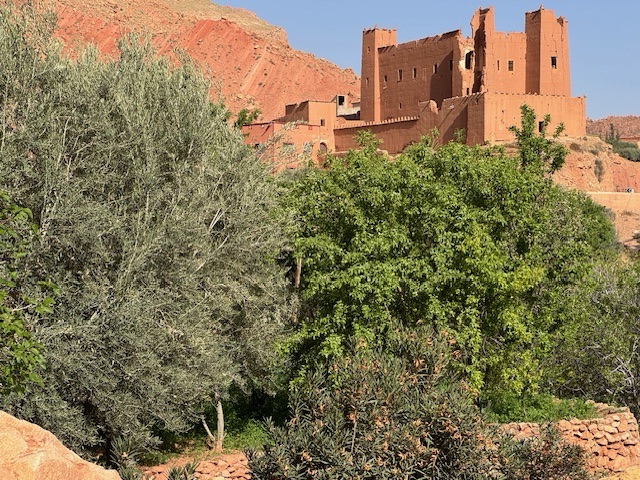
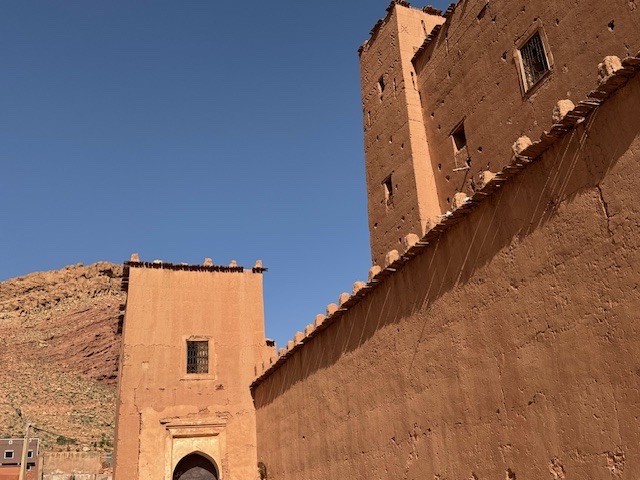
Though time weathered parts of the kasbah, its imposing walls, intricate decorative motifs, and watchtowers still stand as a testament to its builders’ craftsmanship. The surrounding valley, because of the river, provides lush green palm groves and endless dramatic rock formations. We take time to explore courtyards and rooms, learning about the life in Morocco’s historic fortified villages.
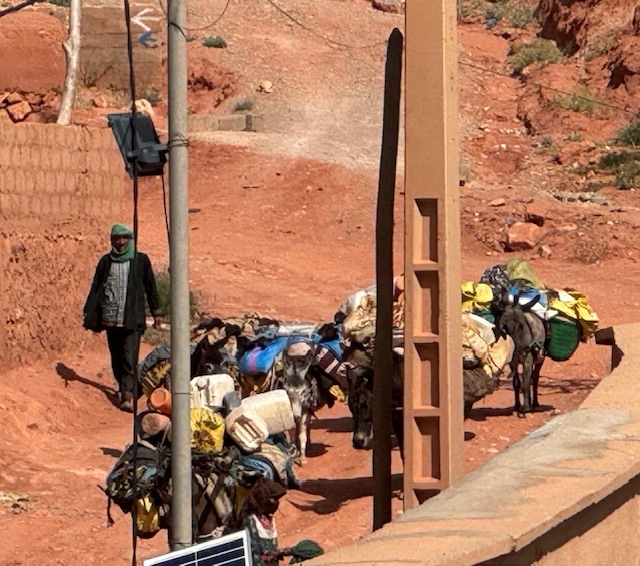
For generations, the valley’s inhabitants lived in these small Kasbah settlements. However, in recent years, many have moved to larger villages along the valley’s edge, leaving only a handful of kasbahs still occupied and well-preserved. The landscape remains a striking blend of rugged cliffs and lush greenery interrupted by these historic fortresses. We just have to maneuver this winding road to get to them.
Samir knows a friend who invited him to come by anytime. Therefore, we enter a true Berber house. It is modern and quite nice. We are served mint tea in the guest lounge. He owns one of the old homes here but it is too costly to restore. As it is a part of historical heritage, he homes the government will eventually restore the ancient residence.
Rivers Don’t Obey Rules and Straight Lines
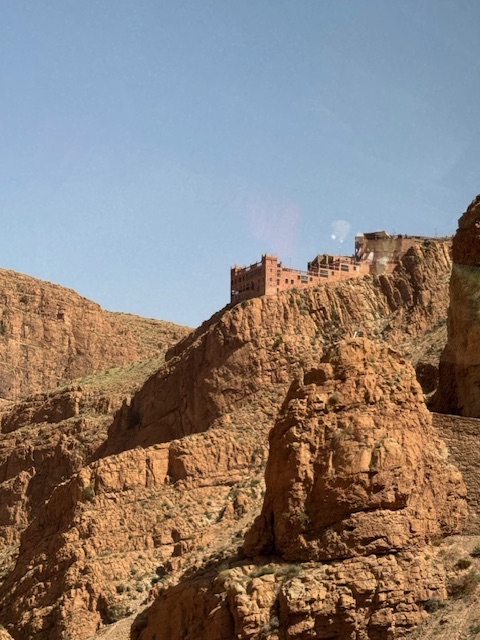
The spectacular Dades Valley stretches between the towering peaks of the High Atlas and the Jbel Saghro mountain range.
The Valley of a Thousand Kasbahs fairly earns the honor of being the most famous of the oasis valleys of southern Morocco.
Fortresses can be seen everywhere atop mountains.
Fed by meltwater from snow-covered peaks, the Dades River carves a dramatic gorge at Aït Oudinar and Aït Ali before flowing southwest across the broad valley toward Ouarzazate.
Looking at the wide river beds, now calm, I covet the beautiful river rock which would look so good in my garden.
Driving in the Dades Gorge is both breathtaking and nerve-wracking, a true adventure. The road snakes its way through towering red cliffs, past rugged rock formations, and alongside the lush oasis edging the Dades River.
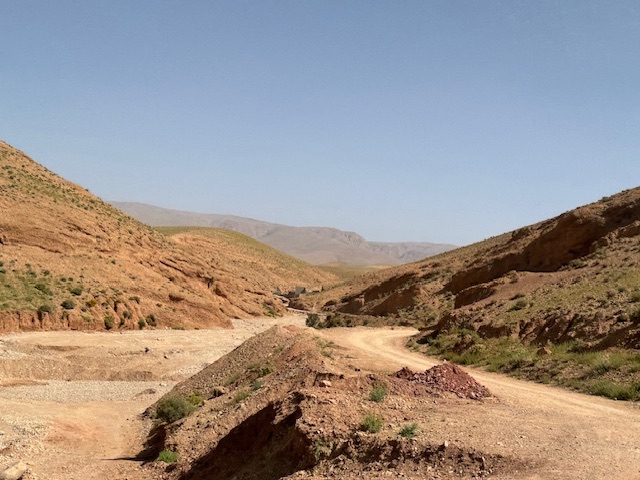
One of the most famous sections is a series of dramatic switchbacks that zigzag up the steep mountainside, offering incredible panoramic views at every turn.

To refer to this as a “road” is exaggeration. Our path consists of what looks to be a lane and a half of narrow, winding pavement.
“This winding road is usually regarded as one of the top 5 most dangerous roads in the world due to its steep gradient and hairpin turns. And let’s just say that Moroccan drivers are not exactly the safest.” – Dangerous Roads
Curves, Switchbacks and Dropoffs
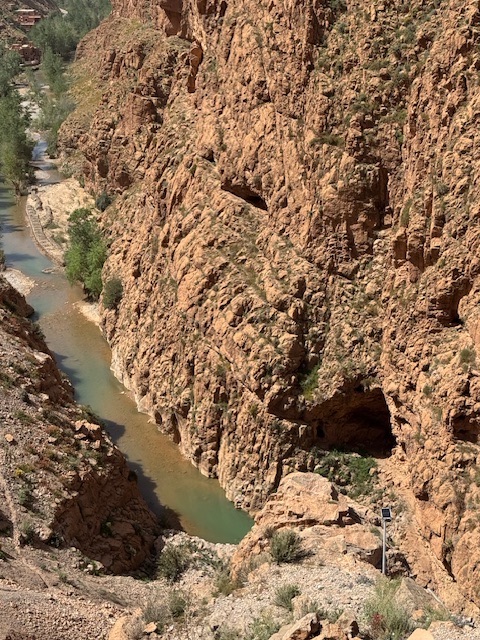
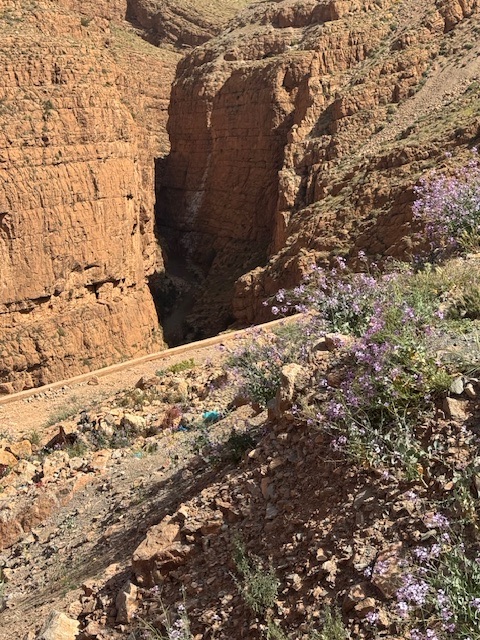
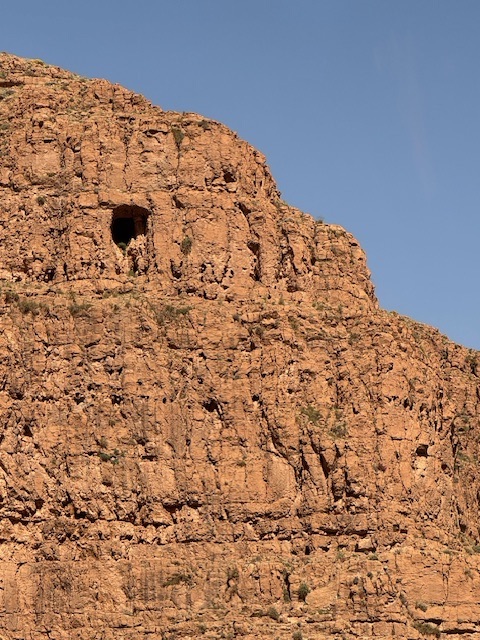
The gorge is about 37 miles long and reaches depths of up to 1640 feet in some places. I see few safety barriers. No amount of mint tea will distract from the curves and dangers of this road. I never received a clear answer as to how many people, and donkeys, plunge down the cliffs to the river below. However, one internet sites mentioned that in some areas we will be just 12 inches from death.
Our driver must focus, as the narrow roads twist sharply with sheer drops on one side and towering cliffs on the other. I am not a white-knuckle, faint-of-heart rider (sections of the Pacific Coast Highway is not all that different), but my stomach does appreciate this morning’s ginger pills.
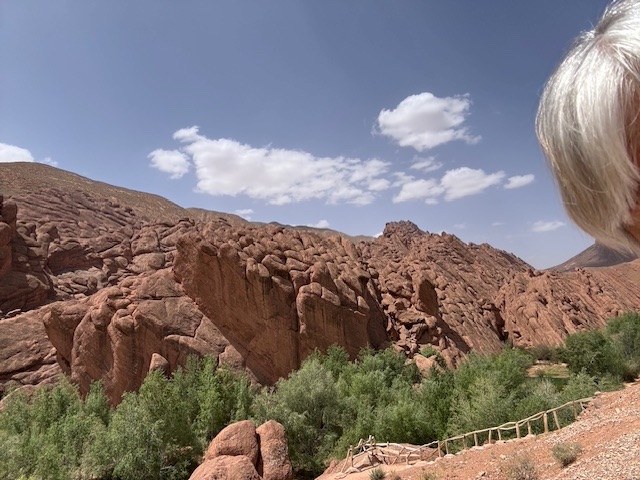
Along the way, small roadside cafés provide a chance to pull over, take a deep breath, and soak in the scenery. Despite the challenges, the journey is unforgettable, offering spectacular views of Morocco’s natural beauty.
Other Roadside Attraction
The 50-mile drive along N10 to our night’s lodgings offers other attractions. The road is lined with markets, villages, reservoirs, slow-moving vehicles, and even the occasional café. Mint tea of course. At truck stops, I head to the freezer for Magnum Bars.
Approaching Ouarzazate, I could see the glow across the desert for over 20 miles. Not a lighthouse, not aliens.
Noor 3 Solar Power Station
The Ouarzazate Solar Power Station, also known as Noor Power Station, is a massive solar energy complex about 6 miles north of Ouarzazate. This represents the world’s largest concentrated solar-thermal power (CSP) plant.

What is CSP technology? This highly efficient technology uses mirrors to reflect and concentrate sunlight onto a receiver. The energy from the concentrated sunlight heats a high temperature fluid in the receiver.
The entire project, covering over 7400 acres, cost around $9 billion. To ensure continuous operation, there exists an auxiliary diesel fuel system. The plant also features a molten salt storage system, allowing it to generate electricity even at night!
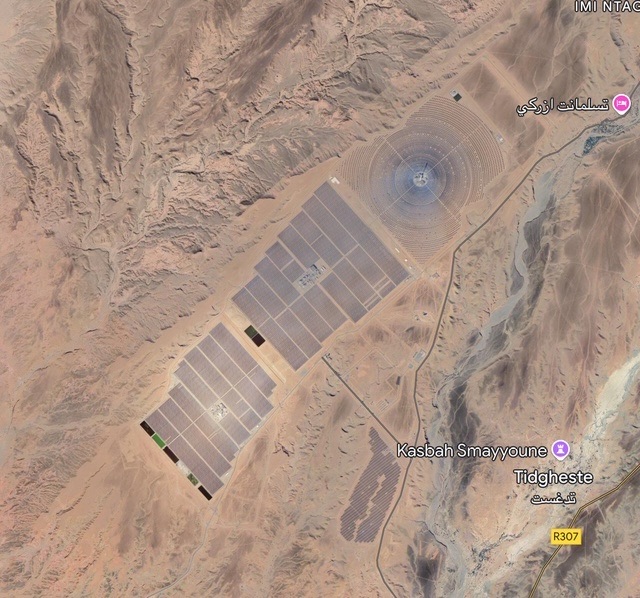
Developed by ACWA Power with support from a Spanish consortium, the project was spearheaded by the Moroccan Agency for Solar Energy. It received financing from organizations such as the Clean Technology Fund, the African Development Bank, the World Bank, and the European Investment Bank, which contributed over 300 million euros.
Okay, U.S.A., this is embarrassing. Where are we, the great advanced industrial nation, when it comes to such ability?
In the U.S., solar power is primarily based on photovoltaic (PV) technology rather than CSP. However, the U.S. does have notable CSP plants, thanks to California’s Ivanpah Solar Electric Generating System, which has a 392 MW capacity (582 MW at Noor) but relies on natural gas for startup and backup power. Another significant CSP project is the Crescent Dunes Solar Energy Project in Nevada, which was a 110 MW molten salt tower but faces operational and financial difficulties.
Overall, the U.S. has much larger total solar power capacity than Morocco, but it relies more on PV rather than CSP. The Noor 3 project stands out for its advanced thermal storage and its ability to generate power after sunset, a feature that many American CSP plants have struggled to implement successfully.
Ouarzazate
The city of Ouarzazate is a sun-drenched desert city, known for its kasbahs, film studios, and stunning mountain-meets-desert landscapes. We lodge overnight at the small boutique Riad Dar Chamaa. Once again, our hotel and rooms are comfortable. Tradition and Moroccan hospitality surrounds us. Always, we are welcomed by an artfully poured cup of mint tea. Rooms are spacious; balconies look out over the city or pool. It becomes easy to get lost in the timelessness of our surroundings.

We meet for Happy Hour. Staff is friendly and happily keep us plied with our favorite beverage around the pool. The Flag Spéciale has proven light and refreshing. Here, beer is chilled and comes with a frosted glass. At $3, beer remains a bargain.
Tomorrow, we are promised visits to movie locations in the area. Personally, I would have preferred visiting the solar plant.

0 Comments